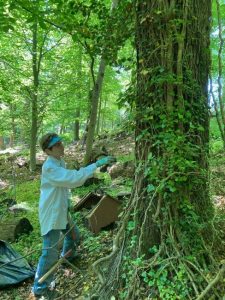Vines and Trees
Invasive vines can pose a significant threat to trees. They can weaken and eventually kill a tree by:
- smothering the tree and blocking vital light from reaching its leaves.
- making the tree more vulnerable to blowing over in a storm due to the vines’ added weight and sail effect catching more wind.
- twisting, girdling, and strangling the tree, cutting off the flow of water and nutrients.
Invasive vines can also smother and kill herbaceous and shrub plants closer to ground level, reducing biodiversity and ecological health.
To protect the health of the urban forest, Takoma Park Code has a provision that requires control of the growth of vines that may damage trees. If you are concerned about Takoma Park’s urban forest, please be a good neighbor by removing invasive vines from your property.
A few comments on vine removal:
- Complete eradication of the invasive vine is ideal, but challenging. If capacity is limited, the priority should be the removal of vines that are growing up trees.
- An infested tree can often be saved simply by cutting the vine near the base of the tree. Since you have cut off its connection to its roots, the vine growth on the tree will die. Periodic cutting will be required as the vine regrows.
- Be careful when excavating the roots of an invasive vine as you do not want to damage the roots of trees or other plants that are to be preserved.
- Make sure not to cut into the tree or rip its bark off as you cut or remove the vine.
Important vine species of concern include:
- Porcelain Berry (Ampelopsis brevipedunculata)
- English Ivy (Hedera helix)
- Kudzu (Pueraria lobate)
- Japanese and Chinese Wisteria (Wisteria floribunda and sinensis)
- Wintercreeper (Euonymous fortunei)
- Japanese Honeysuckle (Lonicera japonica)
A number of groups are active in the area that can help you learn more about invasive vines, how to identify them, and how to remove them from trees:
- See the Chesapeake Climate Action Network’s (CCAN) webpage for a how-to video and instructions for vine removal. Or signup for one of their volunteer events
- Learn what Friends of Sligo Creek is doing.
- Become a Montgomery Parks Weed Warrior and get certified to remove invasive plants in Montgomery Parks, including Sligo Creek, Long Branch, and certain other Takoma Park parks.

